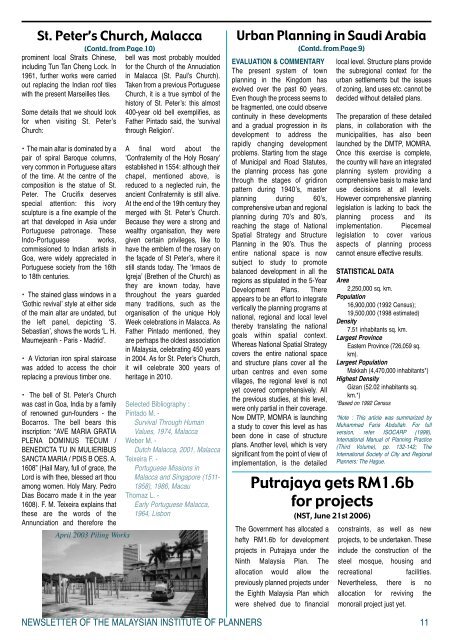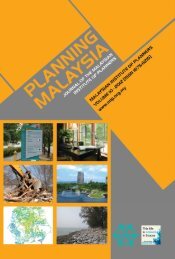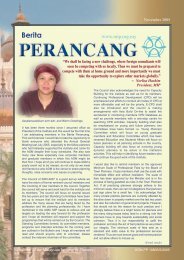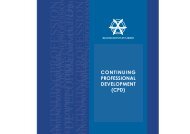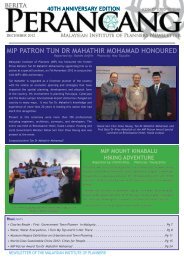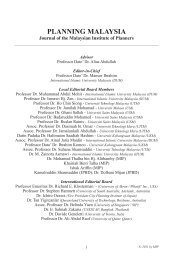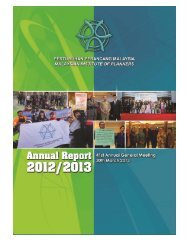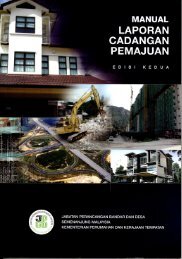Download July 2006 Issue - Malaysian Institute of Planners
Download July 2006 Issue - Malaysian Institute of Planners
Download July 2006 Issue - Malaysian Institute of Planners
You also want an ePaper? Increase the reach of your titles
YUMPU automatically turns print PDFs into web optimized ePapers that Google loves.
St. Peter’s Church, Malacca<br />
prominent local Straits Chinese,<br />
including Tun Tan Cheng Lock. In<br />
1961, further works were carried<br />
out replacing the Indian ro<strong>of</strong> tiles<br />
with the present Marseilles tiles.<br />
Some details that we should look<br />
for when visiting St. Peter’s<br />
Church:<br />
• The main altar is dominated by a<br />
pair <strong>of</strong> spiral Baroque columns,<br />
very common in Portuguese altars<br />
<strong>of</strong> the time. At the centre <strong>of</strong> the<br />
composition is the statue <strong>of</strong> St.<br />
Peter. The Crucifix deserves<br />
special attention: this ivory<br />
sculpture is a fine example <strong>of</strong> the<br />
art that developed in Asia under<br />
Portuguese patronage. These<br />
Indo-Portuguese works,<br />
commissioned to Indian artists in<br />
Goa, were widely appreciated in<br />
Portuguese society from the 16th<br />
to 18th centuries.<br />
• The stained glass windows in a<br />
‘Gothic revival’ style at either side<br />
<strong>of</strong> the main altar are undated, but<br />
the left panel, depicting ‘S.<br />
Sebastian’, shows the words ‘L. H.<br />
Maumejeanh - Paris - Madrid’.<br />
• A Victorian iron spiral staircase<br />
was added to access the choir<br />
replacing a previous timber one.<br />
• The bell <strong>of</strong> St. Peter’s Church<br />
was cast in Goa, India by a family<br />
<strong>of</strong> renowned gun-founders - the<br />
Bocarros. The bell bears this<br />
inscription: “AVE MARIA GRATIA<br />
PLENA DOMINUS TECUM /<br />
BENEDICTA TU IN MULIERIBUS<br />
SANCTA MARIA / PDIS B OES. A.<br />
1608” (Hail Mary, full <strong>of</strong> grace, the<br />
Lord is with thee, blessed art thou<br />
among women. Holy Mary. Pedro<br />
Dias Bocarro made it in the year<br />
1608). F. M. Teixeira explains that<br />
these are the words <strong>of</strong> the<br />
Annunciation and therefore the<br />
(Contd. from Page 10)<br />
April 2003 Piling Works<br />
bell was most probably moulded<br />
for the Church <strong>of</strong> the Annuciation<br />
in Malacca (St. Paul’s Church).<br />
Taken from a previous Portuguese<br />
Church, it is a true symbol <strong>of</strong> the<br />
history <strong>of</strong> St. Peter’s: this almost<br />
400-year old bell exemplifies, as<br />
Father Pintado said, the ‘survival<br />
through Religion’.<br />
A final word about the<br />
‘Confraternity <strong>of</strong> the Holy Rosary’<br />
established in 1554: although their<br />
chapel, mentioned above, is<br />
reduced to a neglected ruin, the<br />
ancient Confraternity is still alive.<br />
At the end <strong>of</strong> the 19th century they<br />
merged with St. Peter’s Church.<br />
Because they were a strong and<br />
wealthy organisation, they were<br />
given certain privileges, like to<br />
have the emblem <strong>of</strong> the rosary on<br />
the façade <strong>of</strong> St Peter’s, where it<br />
still stands today. The ‘Irmaos de<br />
Igreja’ (Brethen <strong>of</strong> the Church) as<br />
they are known today, have<br />
throughout the years guarded<br />
many traditions, such as the<br />
organisation <strong>of</strong> the unique Holy<br />
Week celebrations in Malacca. As<br />
Father Pintado mentioned, they<br />
are perhaps the oldest association<br />
in Malaysia, celebrating 450 years<br />
in 2004. As for St. Peter’s Church,<br />
it will celebrate 300 years <strong>of</strong><br />
heritage in 2010.<br />
Selected Bibliography :<br />
Pintado M. -<br />
Survival Through Human<br />
Values, 1974, Malacca<br />
Weber M. -<br />
Dutch Malacca, 2001, Malacca<br />
Teixeira F. -<br />
Portuguese Missions in<br />
Malacca and Singapore (1511-<br />
1958), 1986, Macau<br />
Thomaz L. -<br />
Early Portuguese Malacca,<br />
1964, Lisbon<br />
Urban Planning in Saudi Arabia<br />
(Contd. from Page 9)<br />
EVALUATION & COMMENTARY<br />
The present system <strong>of</strong> town<br />
planning in the Kingdom has<br />
evolved over the past 60 years.<br />
Even though the process seems to<br />
be fragmented, one could observe<br />
continuity in these developments<br />
and a gradual progression in its<br />
development to address the<br />
rapidly changing development<br />
problems. Starting from the stage<br />
<strong>of</strong> Municipal and Road Statutes,<br />
the planning process has gone<br />
through the stages <strong>of</strong> gridiron<br />
pattern during 1940’s, master<br />
planning during 60’s,<br />
comprehensive urban and regional<br />
planning during 70’s and 80’s,<br />
reaching the stage <strong>of</strong> National<br />
Spatial Strategy and Structure<br />
Planning in the 90’s. Thus the<br />
entire national space is now<br />
subject to study to promote<br />
balanced development in all the<br />
regions as stipulated in the 5-Year<br />
Development Plans. There<br />
appears to be an effort to integrate<br />
vertically the planning programs at<br />
national, regional and local level<br />
thereby translating the national<br />
goals within spatial context.<br />
Whereas National Spatial Strategy<br />
covers the entire national space<br />
and structure plans cover all the<br />
urban centres and even some<br />
villages, the regional level is not<br />
yet covered comprehensively. All<br />
the previous studies, at this level,<br />
were only partial in their coverage.<br />
Now DMTP, MOMRA is launching<br />
a study to cover this level as has<br />
been done in case <strong>of</strong> structure<br />
plans. Another level, which is very<br />
significant from the point <strong>of</strong> view <strong>of</strong><br />
implementation, is the detailed<br />
The Government has allocated a<br />
hefty RM1.6b for development<br />
projects in Putrajaya under the<br />
Ninth Malaysia Plan. The<br />
allocation would allow the<br />
previously planned projects under<br />
the Eighth Malaysia Plan which<br />
were shelved due to financial<br />
local level. Structure plans provide<br />
the subregional context for the<br />
urban settlements but the issues<br />
<strong>of</strong> zoning, land uses etc. cannot be<br />
decided without detailed plans.<br />
The preparation <strong>of</strong> these detailed<br />
plans, in collaboration with the<br />
municipalities, has also been<br />
launched by the DMTP, MOMRA.<br />
Once this exercise is complete,<br />
the country will have an integrated<br />
planning system providing a<br />
comprehensive basis to make land<br />
use decisions at all levels.<br />
However comprehensive planning<br />
legislation is lacking to back the<br />
planning process and its<br />
implementation. Piecemeal<br />
legislation to cover various<br />
aspects <strong>of</strong> planning process<br />
cannot ensure effective results.<br />
STATISTICAL DATA<br />
Area<br />
2,250,000 sq. km.<br />
Population<br />
16,900,000 (1992 Census);<br />
19,500,000 (1998 estimated)<br />
Density<br />
7.51 inhabitants sq. km.<br />
Largest Province<br />
Eastern Province (726,059 sq.<br />
km).<br />
Largest Population<br />
Makkah (4,470,000 inhabitants*)<br />
Highest Density<br />
Gizan (52.02 inhabitants sq.<br />
km.*)<br />
*Based on 1992 Census<br />
*Note : This article was summarized by<br />
Muhammad Faris Abdullah. For full<br />
version, refer ISOCARP (1998),<br />
International Manual <strong>of</strong> Planning Practice<br />
(Third Volume), pp. 132-142; The<br />
International Society <strong>of</strong> City and Regional<br />
<strong>Planners</strong>: The Hague.<br />
Putrajaya gets RM1.6b<br />
for projects<br />
(NST, June 21st <strong>2006</strong>)<br />
constraints, as well as new<br />
projects, to be undertaken. These<br />
include the construction <strong>of</strong> the<br />
steel mosque, housing and<br />
recreational facilities.<br />
Nevertheless, there is no<br />
allocation for reviving the<br />
monorail project just yet.<br />
NEWSLETTER OF THE MALAYSIAN INSTITUTE OF PLANNERS 11


